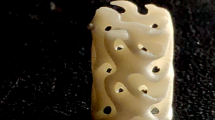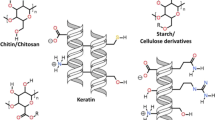Abstract
Three-dimensional (3D) bioprinting has been used widely for the construction of hard tissues such as bone and cartilage. However, constructing soft tissues with complex structures remains a challenge. In this study, complex structures characterized by both tunable elastic modulus and porosity were printed using freeform reversible embedding of suspended hydrogels (FRESHs) printing methods. A mixture of alginate and gelatin was used as the main functional component of the bioink. Rheological analysis showed that this bioink possesses shear thinning and shear recovery properties, supporting both cryogenic and FRESH printing methods. Potential printing capabilities and limitations of cryogenic and FRESH printing were then analyzed by printability tests. A series of complex structures were printed by FRESH printing methods which could not be realized using conventional approaches. Mechanical tests and scanning electron microscopy analysis showed that the printed structure is of excellent flexibility and could be applied in various conditions by adjusting its mechanical modulus and porosity. L929 fibroblast cells maintained cell viability in cell-laden-printed structures, and the addition of collagen further improved the hydrogels’ biocompatibility. Overall, all results provided useful insight into the building of human soft tissue organ blocks.
Graphic abstract











Similar content being viewed by others
References
Zhang B, Luo Y, Ma L et al (2018) 3D bioprinting: an emerging technology full of opportunities and challenges. Bio-Des Manuf 1(1):2–13. https://doi.org/10.1007/s42242-018-0004-3
Ozbolat IT, Yu Y (2013) Bioprinting toward organ fabrication: challenges and future trends. IEEE Trans Biomed Eng 60(3):691–699. https://doi.org/10.1109/TBME.2013.2243912
Park C, Jones MM, Kaplan S et al (2022) A scoping review of inequities in access to organ transplant in the United States. Int J Equity Health 21:22. https://doi.org/10.1186/s12939-021-01616-x
Hurst DJ, Potter J, Padilla LA (2022) Organ transplant and Covid-19 vaccination: considering the ethics of denying transplant to unvaccinated patients. Clin Transplant 36(5):e14589. https://doi.org/10.1111/ctr.14589
Langer R, Vacanti JP (1993) Tissue engineering. Science 260(5110):920–926. https://doi.org/10.1126/science.8493529
Xu Y, Zhang F, Zhai W et al (2022) Unraveling of advances in 3D-printed polymer-based bone scaffolds. Polymers 14(3):566. https://doi.org/10.3390/polym14030566
Kang Y, Xu J, Meng L et al (2023) 3D bioprinting of dECM/Gel/QCS/nHAp hybrid scaffolds laden with mesenchymal stem cell-derived exosomes to improve angiogenesis and osteogenesis. Biofabrication 15(2):024103. https://doi.org/10.1088/1758-5090/acb6b8
Kim DH, Kim MJ, Kwak SY et al (2023) Bioengineered liver crosslinked with nano-graphene oxide enables efficient liver regeneration via MMP suppression and immunomodulation. Nat Commun 14(1):801. https://doi.org/10.1038/s41467-023-35941-2
Liu N, Ye X, Yao B et al (2021) Advances in 3D bioprinting technology for cardiac tissue engineering and regeneration. Bioact Mater 6(5):1388–1401. https://doi.org/10.1016/j.bioactmat.2020.10.021
Lawlor KT, Vanslambrouck JM, Higgins JW et al (2021) Cellular extrusion bioprinting improves kidney organoid reproducibility and conformation. Nat Mater 20(2):260–271. https://doi.org/10.1038/s41563-020-00853-9
Shoulders MD, Raines RT (2009) Collagen structure and stability. Annu Rev Biochem 78:929–958. https://doi.org/10.1146/annurev.biochem.77.032207.120833
Kumar MN, Muzzarelli RA, Muzzarelli C et al (2004) Chitosan chemistry and pharmaceutical perspectives. Chem Rev 104(12):6017–6084. https://doi.org/10.1021/cr030441b
Lee KY, Mooney DJ (2012) Alginate: properties and biomedical applications. Prog Polymer Sci 37:106–126. https://doi.org/10.1016/j.progpolymsci.2011.06.003
Arnott S, Fulmer A, Scott WE et al (1974) The agarose double helix and its function in agarose gel structure. J Mol Biol 90(2):269–284. https://doi.org/10.1016/0022-2836(74)90372-6
Yu K, Zhang X, Sun Y et al (2021) Printability during projection-based 3D bioprinting. Bioact Mater 11:254–267. https://doi.org/10.1016/j.bioactmat.2021.09.021
Gungor-Ozkerim PS, Inci I, Zhang YS et al (2016) Bioinks for 3D bioprinting: an overview. Biomater Sci 6(5):915–946. https://doi.org/10.1039/c7bm00765e
He Y, Yang F, Zhao H et al (2016) Research on the printability of hydrogels in 3D bioprinting. Sci Rep 6:29977. https://doi.org/10.1038/srep29977
Skeldon G, Lucendo-Villarin B, Shu W (2018) Three-dimensional bioprinting of stem-cell derived tissues for human regenerative medicine. Phil Trans R Soc B 373(1750):20170224. https://doi.org/10.1098/rstb.2017.0224
Hölzl K, Lin S, Tytgat L et al (2016) Bioink properties before, during and after 3D bioprinting. Biofabrication 8(3):032002. https://doi.org/10.1088/1758-5090/8/3/032002
Pati F, Jang J, Ha DH et al (2014) Printing three-dimensional tissue analogues with decellularized extracellular matrix bioink. Nat Commun 5:3935. https://doi.org/10.1038/ncomms4935
Corbett DC, Olszewski E, Stevens K (2019) A FRESH take on resolution in 3D bioprinting. Trends Biotechnol 37(11):1153–1155. https://doi.org/10.1016/j.tibtech.2019.09.003
Balmforth NJ, Frigaard IA, Ovarlez G (2014) Yielding to stress: recent developments in viscoplastic fluid mechanics. Annu Rev Fluid Mech 46:121–146. https://doi.org/10.1146/annurev-fluid-010313-141424
Hinton TJ, Hudson A, Pusch K et al (2016) 3D printing PDMS elastomer in a hydrophilic support bath via freeform reversible embedding. ACS Biomater Sci Eng 2(10):1781–1786. https://doi.org/10.1021/acsbiomaterials.6b00170
O'Bryan CS, Bhattacharjee T, Hart S et al (2017) Self-assembled micro-organogels for 3D printing silicone structures. Sci Adv 3(5):e1602800. https://doi.org/10.1126/sciadv.1602800
Colly A, Marquette C, Courtial EJ (2021) Poloxamer/poly(ethylene glycol) self-healing hydrogel for high-precision freeform reversible embedding of suspended hydrogel. Langmuir 37(14):4154–4162. https://doi.org/10.1021/acs.langmuir.1c00018
Lee A, Hudson AR, Shiwarski DJ et al (2019) 3D bioprinting of collagen to rebuild components of the human heart. Science 365(6452):482–487. https://doi.org/10.1126/science.aav9051
Mirdamadi E, Tashman JW, Shiwarski DJ et al (2020) FRESH 3D bioprinting a full-size model of the human heart. ACS Biomater Sci Eng 6(11):6453–6459. https://doi.org/10.1021/acsbiomaterials.0c01133
Zhang Z, Wu C, Dai C et al (2022) A multi-axis robot-based bioprinting system supporting natural cell function preservation and cardiac tissue fabrication. Bioact Mater 18:138–150. https://doi.org/10.1016/j.bioactmat.2022.02.009
Lan X, Liang Y, Erkut EJN et al (2021) Bioprinting of human nasoseptal chondrocytes-laden collagen hydrogel for cartilage tissue engineering. FASEB J 35(3):e21191. https://doi.org/10.1096/fj.202002081R
Ostrovidov S, Salehi S, Costantini M et al (2019) 3D bioprinting in skeletal muscle tissue engineering. Small 15(24):1805530. https://doi.org/10.1002/smll.201805530
Hinton TJ, Jallerat Q, Palchesko RN et al (2015) Three-dimensional printing of complex biological structures by freeform reversible embedding of suspended hydrogels. Sci Adv 1(9):e1500758. https://doi.org/10.1126/sciadv.1500758
Shiwarski DJ, Hudson AR, Tashman JW et al (2021) Emergence of FRESH 3D printing as a platform for advanced tissue biofabrication. APL Bioeng 5:010904. https://doi.org/10.1063/5.0032777
Paxton N, Smolan W, Böck T et al (2017) Proposal to assess printability of bioinks for extrusion-based bioprinting and evaluation of rheological properties governing bioprintability. Biofabrication 9(4):044107. https://doi.org/10.1088/1758-5090/aa8dd8
Lindsay CD, Roth JG, LeSavage BL et al (2019) Bioprinting of stem cell expansion lattices. Acta Biomater 95:225–235. https://doi.org/10.1016/j.actbio.2019.05.014
Lewicki J, Bergman J, Kerins C et al (2019) Optimization of 3D bioprinting of human neuroblastoma cells using sodium alginate hydrogel. Bioprinting 16:e00053. https://doi.org/10.1016/j.bprint.2019.e00053
Kozlov PV, Burdygina GI (1983) The structure and properties of solid gelatin and the principles of their modification. Polymer 24:651–666. https://doi.org/10.1016/0032-3861(83)90001-0
Yang F, Tadepalli V, Wiley BJ (2017) 3D printing of a double network hydrogel with a compression strength and elastic modulus greater than those of cartilage. ACS Biomater Sci Eng 3(5):863–869. https://doi.org/10.1021/acsbiomaterials.7b00094
Sun M, Sun X, Wang Z et al (2018) Synthesis and properties of gelatin methacryloyl (GelMA) hydrogels and their recent applications in load-bearing tissue. Polymers 10(11):E1290. https://doi.org/10.3390/polym10111290
Hoch E, Hirth T, Tovar GEM et al (2013) Chemical tailoring of gelatin to adjust its chemical and physical properties for functional bioprinting. J Mater Chem B 1(41):5675–5685. https://doi.org/10.1039/C3TB20745E
Blaeser A, Duarte Campos DF, Puster U et al (2016) Controlling shear stress in 3D bioprinting is a key factor to balance printing resolution and stem cell integrity. Adv Healthc Mater 5(3):326–333. https://doi.org/10.1002/adhm.201500677
Engler AJ, Sen S, Sweeney HL et al (2006) Matrix elasticity directs stem cell lineage specification. Cell 126(4):677–689. https://doi.org/10.1016/j.cell.2006.06.044
Huebsch N, Arany PR, Mao AS et al (2010) Harnessing traction-mediated manipulation of the cell/matrix interface to control stem-cell fate. Nat Mater 9(6):518–526. https://doi.org/10.1038/nmat2732
Carrow JK, Kerativitayanan P, Jaiswal MK et al (2015) Polymers for bioprinting. In: Atala A, Yoo JJ (Eds.), Essentials of 3D Biofabrication and Translation. Academic Press, Boston, USA, p.229–248. https://doi.org/10.1016/B978-0-12-800972-7.00013-X
Leipzig ND, Shoichet MS (2009) The effect of substrate stiffness on adult neural stem cell behaviour. Biomaterials 30(36):6867–6878. https://doi.org/10.1016/j.biomaterials.2009.09.002
Lee W, Pinckney J, Lee V et al (2009) Three-dimensional bioprinting of rat embryonic neural cells. NeuroReport 20(8):798–803. https://doi.org/10.1097/WNR.0b013e32832b8be4
Hu X, Wang Y, Zhang L et al (2021) Simple ultrasonic-assisted approach to prepare polysaccharide-based aerogel for cell research and histocompatibility study. Int J Biol Macromol 188:411–420. https://doi.org/10.1016/j.ijbiomac.2021.08.034
Ghafari R, Jonoobi M, Amirabad LM et al (2019) Fabrication and characterization of novel bilayer scaffold from nanocellulose based aerogel for skin tissue engineering applications. Int J Biol Macromol 136:796–803. https://doi.org/10.1016/j.ijbiomac.2019.06.104
Shao L, Gao Q, Xie C et al (2020) Sacrificial microgel-laden bioink-enabled 3D bioprinting of mesoscale pore networks. Bio-Des Manuf 3(1):30–39. https://doi.org/10.1007/s42242-020-00062-y
Wang Z, Huang C, Han X et al (2022) Fabrication of aerogel scaffolds with adjustable macro/micro-pore structure through 3D printing and sacrificial template method for tissue engineering. Mater Des 217:110662. https://doi.org/10.1016/j.matdes.2022.110662
Chung JHY, Naficy S, Yue Z et al (2013) Bio-ink properties and printability for extrusion printing living cells. Biomater Sci 1(3):763–773. https://doi.org/10.1039/C3BM00012E
Moncal KK, Ozbolat V, Datta P et al (2019) Thermally-controlled extrusion-based bioprinting of collagen. J Mater Sci Mater Med 30:55. https://doi.org/10.1007/s10856-019-6258-2
Kreimendahl F, Kniebs C, Sobreiro AMT et al (2021) FRESH bioprinting technology for tissue engineering – the influence of printing process and bioink composition on cell behavior and vascularization. J Appl Biomater Funct Mater 19:1–11. https://doi.org/10.1177/22808000211028808
Ahn M, Cho WW, Kim BS et al (2022) Engineering densely packed adipose tissue via environmentally controlled in-bath 3D bioprinting. Adv Funct Mater 32:2200203. https://doi.org/10.1002/adfm.202200203
Acknowledgements
This work was financially supported by the National Natural Science Foundation of China (Nos. 52275464 and 52075300) and the Scientific Research Project for National High-Level Innovative Talents of Hebei Province Full-Time Introduction (No. 2021HBQZYCXY004).
Author information
Authors and Affiliations
Contributions
ZC participated in conceptualization, investigation, methodology, and writing of the original draft. CZH was involved in supervision, conceptualization, writing—review & editing, and funding acquisition. HLL was involved in methodology. XH, ZCW, and SYL contributed to writing—review & editing. JH and ZW contributed to supervision and writing—review & editing.
Corresponding author
Ethics declarations
Conflict of interest
CZH is an Editorial Board Member of Bio-Design and Manufacturing. The authors declare that they have no known competing financial interests or personal relationships that could have appeared to influence the work reported in this paper.
Ethical approval
This study does not contain any studies with human or animal subjects performed by any of the authors.
Data or code availability
The data generated in this study are available from the corresponding author upon reasonable request.
Rights and permissions
Springer Nature or its licensor (e.g. a society or other partner) holds exclusive rights to this article under a publishing agreement with the author(s) or other rightsholder(s); author self-archiving of the accepted manuscript version of this article is solely governed by the terms of such publishing agreement and applicable law.
About this article
Cite this article
Chen, Z., Huang, C., Liu, H. et al. 3D bioprinting of complex biological structures with tunable elastic modulus and porosity using freeform reversible embedding of suspended hydrogels. Bio-des. Manuf. 6, 550–562 (2023). https://doi.org/10.1007/s42242-023-00251-5
Received:
Accepted:
Published:
Issue Date:
DOI: https://doi.org/10.1007/s42242-023-00251-5




